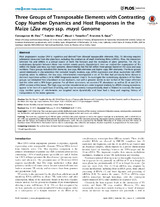Three Groups of Transposable Elements with Contrasting Copy Number Dynamics and Host Responses in the Maize (Zea mays ssp. mays) Genome
Autor
Díez, Concepción M.
Meca, Esteban
Tenaillon, Maud I.
Gaut, Brandon S.
Editor
Public Library of ScienceFecha
2014Materia
Small interfering RNAsPlant genomics
Maize
Genomic libraries
Transposable elements
Genomic databases
Sequence databases
Genome evolution
METS:
Mostrar el registro METSPREMIS:
Mostrar el registro PREMISMetadatos
Mostrar el registro completo del ítemResumen
Most angiosperm nuclear DNA is repetitive and derived from silenced transposable elements (TEs). TE silencing requires
substantial resources from the plant host, including the production of small interfering RNAs (siRNAs). Thus, the interaction
between TEs and siRNAs is a critical aspect of both the function and the evolution of plant genomes. Yet the coevolutionary
dynamics between these two entities remain poorly characterized. Here we studied the organization of TEs
within the maize (Zea mays ssp mays) genome, documenting that TEs fall within three groups based on the class and copy
numbers. These groups included DNA elements, low copy RNA elements and higher copy RNA elements. The three groups
varied statistically in characteristics that included length, location, age, siRNA expression and 24:22 nucleotide (nt) siRNA
targeting ratios. In addition, the low copy retroelements encompassed a set of TEs that had previously been shown to
decrease expression within a 24 nt siRNA biogenesis mutant (mop1). To investigate the evolutionary dynamics of the three
groups, we estimated their abundance in two landraces, one with a genome similar in size to that of the maize reference
and the other with a 30% larger genome. For all three accessions, we assessed TE abundance as well as 22 nt and 24 nt
siRNA content within leaves. The high copy number retroelements are under targeted similarly by siRNAs among accessions,
appear to be born of a rapid bust of activity, and may be currently transpositionally dead or limited. In contrast, the lower
copy number group of retrolements are targeted more dynamically and have had a long and ongoing history of
transposition in the maize genome.
Fuente
PLoS Genet 10(4): e1004298 (2014)Versión del Editor
http://dx.doi.org/10.1371/journal.pgen.1004298Ítems relacionados
Mostrando ítems relacionados por Título, autor o materia.
-
An AP Endonuclease Functions in Active DNA Demethylation and Gene Imprinting in Arabidopsis
Li, Yan; Córdoba-Cañero, Dolores; Qian, Weiqiang; Zhu, Xiaohong; Tang, Kai; Zhang, Huiming; Rodríguez Ariza, Rafael; Roldán-Arjona, Teresa; Zhu, Jian-Kang (Public Library of Science, 2015)Active DNA demethylation in plants occurs through base excision repair, beginning with removal of methylated cytosine by the ROS1/DME subfamily of 5-methylcytosine DNA glycosylases. Active DNA demethylation in animals ... -
Integrating agronomic and genomic approaches for wheat adaptation to to Southern Spain Mediterranean agro-environments
Mérida García, Mª Rosa (Universidad de Córdoba, UCOPress, 2019)Wheat (Triticum spp.) is one of the oldest domesticated crops and is of great importance as a staple food in the human diet. It shows an interesting phenotypic plasticity conferred by a large, polyploid and complex genome. ... -
A genome-wide analysis of the RNA-guided silencing pathway in coffee reveals insights into its regulatory mechanisms
Fernandes-Brum, Christiane Noronha; Marinho Rezende, Pâmela; Cherubino Ribeiro, Thales Henrique; Ricon de Oliveira, Raphael; Cunha de Sousa Cardoso, Thaís; Rodrigues do Amaral, Laurence; Souza Gomes, Matheus de; Chalfun-Junior, Antonio (Public Library of Science, 2017)microRNAs (miRNAs) are derived from self-complementary hairpin structures, while small-interfering RNAs (siRNAs) are derived from double-stranded RNA (dsRNA) or hairpin precursors. The core mechanism of sRNA production ...

